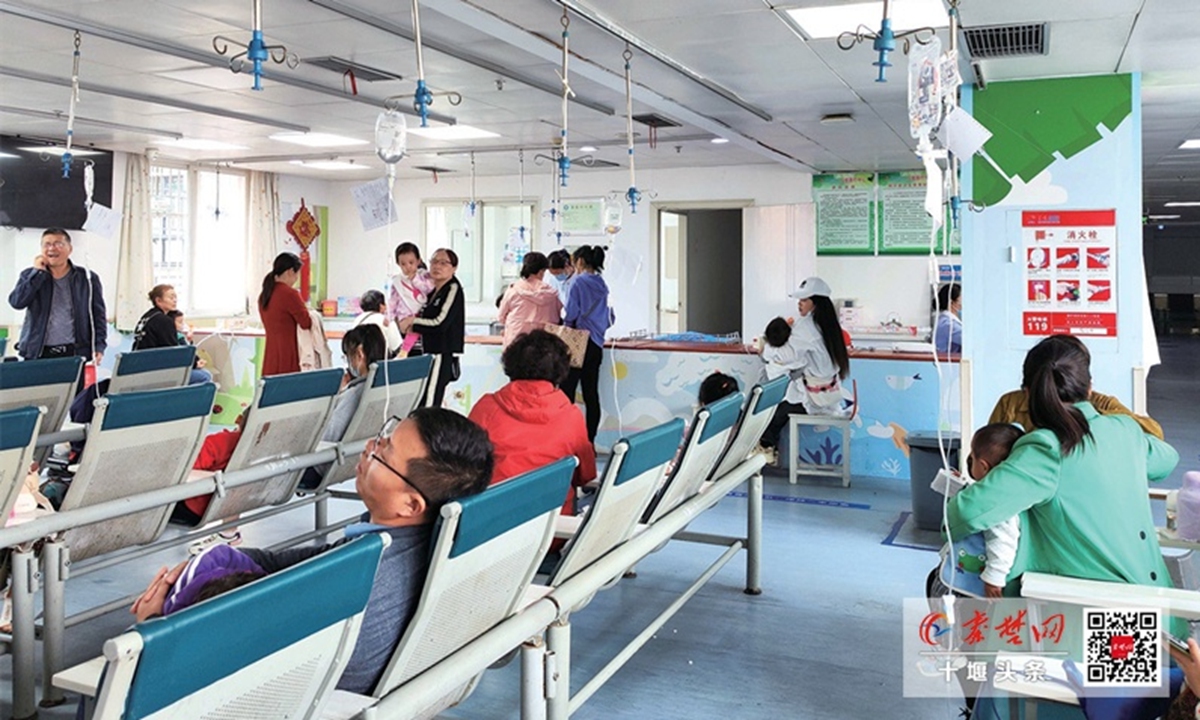
Some children with mycoplasma pneumoniae infection get IVs in the outpatient hall of the children's medical center at Guoyao Dongfeng General Hospital in Shiyan in Central China's Hubei Province on October 12, 2023. Photo: from Shiyan Daily.
In recent days, there has been a surge in cases of infection by the bacterium mycoplasma pneumoniae reported in multiple hospitals across the country, with children being the most affected. This year, the infection has occurred earlier than usual and has shown a trend toward affecting younger children, leading pediatricians to warn that this year could see a widespread outbreak of mycoplasma pneumonia.
Li Tongzeng, the chief physician of the infection department at Beijing You'an Hospital, told the Global Times on Thursday that before the COVID-19 pandemic, a relatively large outbreak of mycoplasma pneumoniae infections would occur every three to seven years. In the past three years, the incidence of respiratory diseases has decreased due to pandemic prevention and control measures. However, this situation may lead to insufficient immunity, especially for children.
With the adjustment of COVID-19 prevention and control measures, the number of mycoplasma pneumoniae infections this year may significantly increase compared to the previous three years, Li predicted.
According to experts, the peak period of mycoplasma pneumoniae infections occurred earlier this year, in July and August. Since July, Shanghai Children's Medical Center has admitted nearly 400 children with mycoplasma pneumoniae infections, which is twice the number compared to previous years, accounting for approximately 80 percent of all respiratory infections, according to a news report by chinanews.com on Thursday.
Doctors at the Beijing Children's Hospital in Shunyi district revealed that since the start of the school year on September 1, there has been a noticeable increase in the number of children being treated in the pediatric department, more than half of whom are children with respiratory symptoms caused by mycoplasma pneumoniae infection, the report noted.
Similarly, during the Mid-Autumn Festival and National Day holidays from September 29 to October 6, the fever clinic at the Guangzhou Women and Children's Medical Center received a record-breaking number of over 1,000 patients in a single day, with respiratory tract infections, particularly mycoplasma pneumoniae infections, being predominant.
"In previous years, the number of cases would decline after a quarter, but this year it has continued for over five months," said doctor Li Shuhua, the head of the pediatric outpatient department at the Guangzhou Women and Children's Medical Center. Since June, the positive rate for mycoplasma pneumoniae infections has been on the rise, and currently, a significant proportion, around 20 to 30 percent, of patients seeking treatment for various respiratory infections have been found to be infected with mycoplasma pneumoniae, Li Shuhua said.
Li Tongzeng stated that after mycoplasma pneumoniae infection, most people have symptoms of upper respiratory tract infection, such as fever, cough, sore throat, nasal congestion and runny nose. A small number of cases will develop pneumonia with repeated high fever and severe cough. He noted that early treatment can reduce the incidence of severe disease.
In February, the National Health Commission issued the 2023 Guidelines for the Diagnosis and Treatment of Mycoplasma Pneumonia in Children, which states that mycoplasma pneumonia is more common in children aged 5 and above, but can also occur in children under 5.
Compared to previous years, the disease in China has shown a trend of affecting younger children, with some cases occurring in children under 3. When related symptoms appear, parents should promptly seek medical attention for their children, pediatricians stressed.
According to chinanews.com, Chang Hesheng, deputy chief physician of the pediatrics department at Beijing Chaoyang Hospital, explained that although mycoplasma pneumoniae infection is not classified as a contagious disease, it does have the ability to spread, primarily through droplet transmission. Currently, there is no specific vaccine available for the prevention of the infection.




